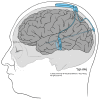Responsive Neurostimulation for Seizure Control: Current Status and Future Directions
- PMID: 36359197
- PMCID: PMC9687706
- DOI: 10.3390/biomedicines10112677
Responsive Neurostimulation for Seizure Control: Current Status and Future Directions
Abstract
Electrocorticography (ECoG) data are commonly obtained during drug-resistant epilepsy (DRE) workup, in which subdural grids and stereotaxic depth electrodes are placed on the cortex for weeks at a time, with the goal of elucidating seizure origination. ECoG data can also be recorded from neuromodulatory devices, such as responsive neurostimulation (RNS), which involves the placement of electrodes deep in the brain. Of the neuromodulatory devices, RNS is the first to use recorded ECoG data to direct the delivery of electrical stimulation in order to control seizures. In this review, we first introduced the clinical management for epilepsy, and discussed the steps from seizure onset to surgical intervention. We then reviewed studies discussing the emergence and therapeutic mechanism behind RNS, and discussed why RNS may be underperforming despite an improved seizure detection mechanism. We discussed the potential utility of incorporating machine learning techniques to improve seizure detection in RNS, and the necessity to change RNS targets for stimulation, in order to account for the network theory of epilepsy. We concluded by commenting on the current and future status of neuromodulation in managing epilepsy, and the role of predictive algorithms to improve outcomes.
Keywords: EEG processing for feedback control of seizure; mathematic modeling of EEG; seizure controllability; seizure detection; seizure prediction; seizure suppression by electrical stimulation; system identification of EEG.
Conflict of interest statement
The authors declare no conflict of interest.
Figures
References
-
- Helbig I., Scheffer I.E., Berkovic S.F. Genetic Epilepsies. Mol. Neurol. 2007;24:371–383. doi: 10.1016/B978-012369509-3.50026-3. - DOI
-
- Scheffer I.E., Berkovic S., Capovilla G., Connolly M.B., French J., Guilhoto L., Hirsch E., Jain S., Mathern G.W., Mosh S.L., et al. ILAE classification of the epilepsies: Position paper of the ILAE Commission for Classification and Terminology. Epilepsia. 2017;58:512–521. doi: 10.1111/epi.13709. - DOI - PMC - PubMed
Publication types
LinkOut - more resources
Full Text Sources



